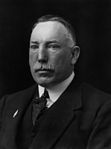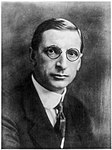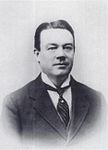1921 Irish elections
| |||||||||||||||||||||||||
128 seats in the House of Commons of Southern Ireland | |||||||||||||||||||||||||
|---|---|---|---|---|---|---|---|---|---|---|---|---|---|---|---|---|---|---|---|---|---|---|---|---|---|
| |||||||||||||||||||||||||
Two elections in Ireland took place in 1921, as a result of the Government of Ireland Act 1920 to establish the House of Commons of Northern Ireland and the House of Commons of Southern Ireland. The election was used by Irish Republicans as the basis of membership of the Second Dáil. Where contested, the elections used single transferable vote.
Contents
1 Southern Ireland result
2 Northern Ireland result
2.1 Voting summary
2.2 Seats summary
3 See also
4 References
Southern Ireland result
No actual polling took place in Southern Ireland as all 128 candidates were returned unopposed. Of these, 124 were won by Sinn Féin and four by independent Unionists representing the University of Dublin (Trinity College).[1] When the date of the elections was announced in the House of Commons, the Conservative MP Sir William Davison, who had been born in Broughshane, County Antrim, had asked "What is the object of holding elections in Southern Ireland when any candidates who do not support Sinn Fein would be shot?" Other members had replied "How do you know?"[2]
A single Unionist candidate had been selected to contest the constituency of Donegal: Major Robert L Moore, who had contested East Donegal in 1918.[3] Moore however later withdrew his candidacy just before the election.[4][5]
| 1921 Southern Ireland general election | ||||
|---|---|---|---|---|
| Party | Leader | No. of seats | % of seats | |
Sinn Féin | Éamon de Valera | 124 | 96.9 | |
Independent Unionist | 4 | 3.1 | ||
Totals | 128 | 100 | ||
Only Sinn Féin candidates recognised the Dáil and five of these had been elected in two constituencies (Michael Collins, Éamon de Valera, Arthur Griffith, Seán Milroy and Eoin MacNeill) one in each part of Ireland. The total number of members who assembled in the Second Dáil was 125: 119 elected solely in Southern Ireland, 1 solely in Northern Ireland (Seán O'Mahony), and 5 in both.
In Southern Ireland, there were fresh elections in 1922 as a result of the Anglo-Irish Treaty.
Northern Ireland result
| |||||||||||||||||||||||||||||||||||||
All 52 seats to the Northern Ireland House of Commons 27 seats were needed for a majority | |||||||||||||||||||||||||||||||||||||
|---|---|---|---|---|---|---|---|---|---|---|---|---|---|---|---|---|---|---|---|---|---|---|---|---|---|---|---|---|---|---|---|---|---|---|---|---|---|
| |||||||||||||||||||||||||||||||||||||
 Percentage of seats gained by each of the party. | |||||||||||||||||||||||||||||||||||||
| |||||||||||||||||||||||||||||||||||||
The general election to the Northern Ireland House of Commons occurred on 24 May. Of 52 seats, including Queen's University of Belfast, 40 were won by Unionists, 6 by moderate nationalists and 6 by Sinn Féin.
| 1921 Northern Ireland general election | ||||||
|---|---|---|---|---|---|---|
| Party | Leader | Seats | % of seats | Votes | % of votes | |
Ulster Unionist Party | James Craig | 40 | 76.9 | 343,347 | 66.9 | |
Sinn Féin | Éamon de Valera | 6 | 11.5 | 104,917 | 20.5 | |
Nationalist Party (NI) | Joe Devlin | 6 | 11.5 | 60,577 | 11.8 | |
Belfast Labour Party | 0 | 0 | 3,075 | 0.6 | ||
Independent | 0 | 0 | 926 | 0.2 | ||
Totals | 52 | 100 | 512,842 | 100 | ||
Voting summary
Seats summary
See also
- Members of the 2nd Dáil
- Government of the 2nd Dáil
- 1918 Irish general election
References
^
"Dáil elections since 1918". ARK Northern Ireland. Retrieved 26 April 2009..mw-parser-output cite.citation{font-style:inherit}.mw-parser-output q{quotes:"""""""'""'"}.mw-parser-output code.cs1-code{color:inherit;background:inherit;border:inherit;padding:inherit}.mw-parser-output .cs1-lock-free a{background:url("//upload.wikimedia.org/wikipedia/commons/thumb/6/65/Lock-green.svg/9px-Lock-green.svg.png")no-repeat;background-position:right .1em center}.mw-parser-output .cs1-lock-limited a,.mw-parser-output .cs1-lock-registration a{background:url("//upload.wikimedia.org/wikipedia/commons/thumb/d/d6/Lock-gray-alt-2.svg/9px-Lock-gray-alt-2.svg.png")no-repeat;background-position:right .1em center}.mw-parser-output .cs1-lock-subscription a{background:url("//upload.wikimedia.org/wikipedia/commons/thumb/a/aa/Lock-red-alt-2.svg/9px-Lock-red-alt-2.svg.png")no-repeat;background-position:right .1em center}.mw-parser-output .cs1-subscription,.mw-parser-output .cs1-registration{color:#555}.mw-parser-output .cs1-subscription span,.mw-parser-output .cs1-registration span{border-bottom:1px dotted;cursor:help}.mw-parser-output .cs1-hidden-error{display:none;font-size:100%}.mw-parser-output .cs1-visible-error{font-size:100%}.mw-parser-output .cs1-subscription,.mw-parser-output .cs1-registration,.mw-parser-output .cs1-format{font-size:95%}.mw-parser-output .cs1-kern-left,.mw-parser-output .cs1-kern-wl-left{padding-left:0.2em}.mw-parser-output .cs1-kern-right,.mw-parser-output .cs1-kern-wl-right{padding-right:0.2em}
^ "New Parliaments". Parliamentary Debates (Hansard). 140. HC. 5 April 1921.
^ The Evening Leader, Corning, NY, 22 April 1921, P2
^ The Sunday Oregonian. (Portland, Ore.) May 15, 1921, Section One, Image 3
^ New-York tribune., May 14, 1921, Page 2, Image 2, citing Associated Press



